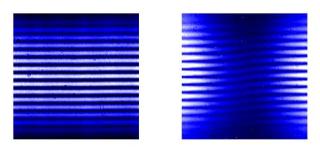Jul 24 2017
IMS Researchers and their colleagues have theoretically and experimentally demonstrated that vortex photons are emitted by a high-energy electron that moves circularly or spirally, in the complete wavelength range from the radio-wave to the gamma-rays.
This study considerably widens the application spectra of the vortex photons in the discipline of physical science. In addition, the discovery shows that vortex photons are omni-present in the cosmos. It opens the door to an entirely new discipline of research, namely, natural vortex photon science.
 UV radiation from a relativistic electron beam is diffracted by a double-slit. In contrast to the normal light (left), the diffraction shows a deformation in the central part (right), indicating the existence of the phase singularity, which is a definite evidence of the vortex nature. CREDIT: Institute for Molecular Science.
UV radiation from a relativistic electron beam is diffracted by a double-slit. In contrast to the normal light (left), the diffraction shows a deformation in the central part (right), indicating the existence of the phase singularity, which is a definite evidence of the vortex nature. CREDIT: Institute for Molecular Science.
Light is a wave and as it is at times termed as an electromagnetic wave, electric and magnetic fields oscillate and the oscillations travel in space. In general, light includes a planar wave front. On the contrary, optical vortex includes helical wave front and transports with it orbital angular momentum. Occurrence of such distinctive photons was theoretically speculated nearly two and a half decades ago. At present, these photons can be easily synthesized in laboratories by means of special optical devices, even though the wavelengths are restricted near the visible light spectrum.
Scientists are investigating the use of these photons in nanotechnology as well as information/communication and imaging technologies. Besides, excluding only very few theoretical suggestions that normal photons can be transformed into vortex photons under a strong gravitational field surrounding a rotating black hall or when passing through inhomogeneous interstellar media, a natural elementary process for synthesizing vortex photons is not known yet.
Nearly a decade ago, a theoretical proposal was made that an undulator—a device largely used in modern synchrotron light sources—can synthesize vortex photons in the X-ray range. After many years, this was experimentally validated at a German synchrotron. Yet, much of the important properties of optical vortex production have been unverified to date. IMS Researchers and their colleagues theoretically explored this process and have discovered that it is dependent on a more conventional and elementary process.
They have demonstrated that an electron traveling in spiral or circular motion emits vortex photons. As this process is fundamental to many significant radiation processes in the fields of Plasma Physics or Astrophysics—for example, synchrotron radiation, cyclotron radiation or Compton scattering—it has been reported in various research papers and textbooks.
Yet, thus far, the vortex nature of this radiation has not been analyzed. Based on the physical condition, the wavelength of this radiation extends from the radio wave to the gamma-rays. The innovative discovery shows that vortex photons are synthesized in many situations in the cosmos, along the complete wavelength range.
In addition, the IMS Researchers and their colleagues were successful in accurately performing accurate experimental observation of the undulator radiation emitted from a synchrotron light source—UVSOR-III—for the first time. After observing the UV light radiating from an electron beam traveling in a spiral way, they showed that a distinctive structure known as phase singularity occurs at the center of the photon beam emitted from the undulator. Furthermore, photons with higher energy have been demonstrated to carry larger angular momenta. These observations firmly back the theoretical proposal.
Vortex photons should be ubiquitous in the universe. What kind of role do they play in nature? Our achievement opens up a totally new research field.
Professor Masahiro Katoh, IMS